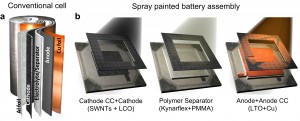Spray-on battery, 3D printing
 Rice University demos a process to spray-on batteries. This is Another step towards fully automated fabrication.
Rice University demos a process to spray-on batteries. This is Another step towards fully automated fabrication.
It was easy to predict that 3D printing would be able to make electronic parts. The process Rice uses probably doesn’t actually need 3D printing to work but it fits the concept. Multiple layers of different materials are sprayed on a surface to create a battery.
Circuits are already being made using normal 2D printers by varying the thickness of the traces to create resistors and conductors. By using a 2 or 3 different materials the full range of electronic parts could be printed directly into the circuit so a robot could literally print a copy of itself. Stratasys and Optomec have already printed electronics.
The spray-on battery will make it easier to build batteries of different shapes and sizes. It will also make it possible for nearly anyone to make batteries anywhere in the world. This can drastically reduce the real costs in terms of time and materials.
3D modelling as easy as playing with dolls
This simple device will change the world! It’s an essential step to breaking down the barrier to robotics, 3D printing, and 3D media.
This action figure allows anyone with a computer and free software to create 3D animations. Move the arm of the doll and the arm on the screen moves the same way. This is the most intuitive way to work.
Powerful low cost computers and free software have enabled anyone to produce media as good or better than professionals. Even though the basic tool are available to anyone, 3D modeling has remained too difficult for most people because it required specialized skills to draw the models. A literal hand-on user interface bring 3D modeling to anyone.
The difficulty of 3D modeling isn’t just a problem for media it limits the progress of 3D fabricating like 3D printing and CNC. If you can literally move objects you can focus on the results instead of how to communicate with the computer.
Using a computer allows you to do many things you can’t just by hand. You can work on objects much smaller or larger than you could in real life. You can record the movements then edit those movements later or make small adjustments . After recording the movements you can play them back or direct robot / printer / CNC machine to perform the task. And the machine can do it much faster or slower than you can manually do. This opens up vast possibilities.
Simple intuitive user interfaces combined with exiting robotics will change the world.
Learn how to program a robotic car in 7 weeks
Two years ago in “Why We Don’t Have Flying Cars, Yet” I explained why automation is the next big innovation for vehicles, not alternative energy.
Standford is offering a 7 week undergraduate class teaching how to program a self-driving car. Automation improves the under-satisfied outcome of cars but it is also technologically easier to make than low-cost long range batteries for an electric car.
The Predictive Innovation report the video was based on was first offered to GM but they turned it down. European and Asian car companies used the information and are now selling cars with automated driving features.
 Volvo’s XC60 has a City Safety feature that automatically brakes to prevent crashes. It’s a pure gasoline car with lots of room and power. It is priced about the same as the Chevy Volt, although doesn’t receive any of the government incentives.
Volvo’s XC60 has a City Safety feature that automatically brakes to prevent crashes. It’s a pure gasoline car with lots of room and power. It is priced about the same as the Chevy Volt, although doesn’t receive any of the government incentives.
| 2011 US Car Sales | |
| Car | Units Sold |
| Chevy Volt | 7,671 |
| Volvo XC60 | 12,932 |
The Volvo XC60 with City Safe automatic braking sold 68% more cars in the USA than Chevy Volt. So not only was it easier to build, and thus more profitable, it sold more units. The automated car is more desirable to customers. One of the key points of the report was to offer incremental improvements with meaningful value to customers. That made sure the new features were high quality and low cost.
In addition to satisfying safety, automated cars are better for the environment than an electric car. Electric cars just shift the source of pollution from burning gasoline in the car to burning coal at a power plant. Automated cars use less energy.
First, replacing or repairing a car damaged in an accident uses more energy than the car ever will from driving it. And how can you count the cost of injuries and deaths?
Secondly, by reducing traffic congestion automated cars can save energy for all the cars on the road while reducing drive times and frustration.
Automation in vehicles is still a big innovation opportunity.



 Predictive Innovation Training
Predictive Innovation Training Predictive Innovation: Core Skills Book
Predictive Innovation: Core Skills Book RoundSquareTriangle.com
RoundSquareTriangle.com